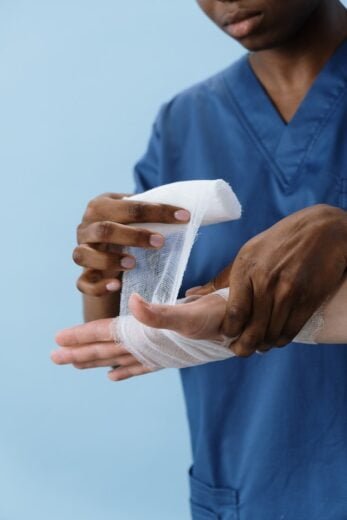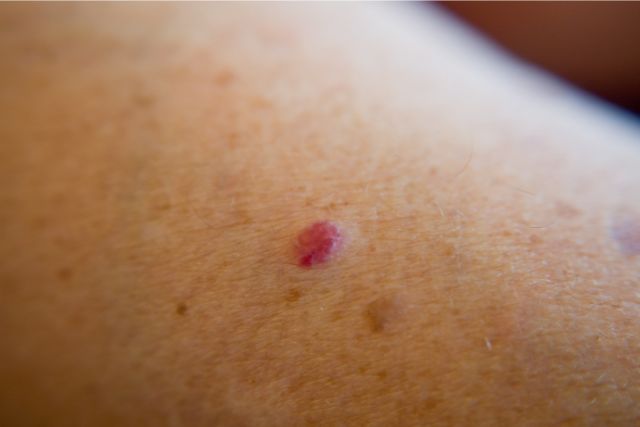Merkel cell carcinoma, abbreviated as MCC, is a rare type of skin cancer. It is characterized by the appearance of malignant cells on the skin in the form of a fast-growing painless lump. Usually, the spot or mass becomes reddish and slightly raised.
However, the causative agent responsible for the disease is a virus named Merkel cell polyomavirus, the incidence risk is higher in individuals with considerably high skin exposure as well as a compromised immune system.
When it comes to its detection, several medical equipment as well as supplies are employed. Let us understand which items are necessarily needed to make an early diagnosis of the disease.

Early Detection: Dermatological Equipment & Supplies
First and foremost, a general examination is performed in which a physician looks for any spots, masses, or moles on the cutaneous tissue. If she or he deems it necessary, a sample from the affected area is collected and sent to the laboratory for further testing.
· Dermoscope:
A dermoscope is a small, compact, and portable device that is employed by the physician to take a closer look at the patient’s skin, hair, or nails.
The efficiency of the dermoscope can be estimated by the fact that it allows the visualization of microstructures of the epidermal layer as well as the dermo-epidermal junction.
A dermoscope also facilitates the in vivo evaluation of the pinkish mass. The device, being non-invasive, also ensures patient comfort.
· Biopsy Kits:
Merkel cell carcinoma can also be detected by taking a sample from the skin tissue which is further examined under a microscope. Sterile scalpels, forceps, as well as specimen containers included in a biopsy kit, are employed for this purpose. This test not only detects the presence of carcinoma but also evaluates the stage at which the disease occurs.
· MRI/PET/CT scanners:
Running an MRI/PET/CT scan on a patient for the purpose of detecting Merkel cell carcinoma is one of the most reliable methods.
This approach not only evaluates the metastasis into the soft tissues but also confirms whether the brain and bone marrow are intact or affected by the carcinoma.
Despite the fact that the Merkel cell carcinoma rarely undergoes neurological penetration, some MCC patients might show modifications in their central nervous system which makes it necessary to run the scan.
· Identification of histological markers:
Another way of making a diagnosis of Merkel cell carcinoma is to check the level of certain cellular as well as tissue components that serve as the so-called markers of the disease.
The presence of neurofilaments, nerve growth factor receptors, peripherin, as well as neuronal cell adhesion molecules indicates the presence of the disease as these components are absent in normal Merkel cells.
Moreover, cytokeratins (CK) 8, 18, 19, and 20 also serve as the histological markers for Merkel cell carcinoma. Examination kits are available in the market to run this test.
Treatment Modalities: Essential Medical Supplies
To treat Merkel cell carcinoma, two major processes are performed which include surgery which is followed by radiation therapy as an adjuvant therapy. Surgical removal of the affected area ensures the elimination of the cancerous mass out of the body while radiation therapy focuses on restricting the regrowth of cancerous tissue. Supplies and equipment needed for this purpose include the following:
· Surgical Supplies:
During surgery, a reddened mass is removed from the skin using a dissecting tool such as a sterile scalpel. Once removed, the area is sutured and covered with a sterile wound dressing to prevent the initiation of an infection.
· Radiation Equipment:
Equipment that can deliver high-energy X-rays or any other type of radiation is employed either to kill the cancerous mass present in the skin or to hinder its regrowth. Being a non-invasive method, these X-ray machines deliver radiation without causing pain or discomfort to the patient.
Apart from the above-mentioned methods, a patient with Merkel cell carcinoma can also be subjected to chemotherapy as well as immunotherapy. Additionally, newer methods are also being introduced which are in different stages of clinical trials.

All of the medical supplies mentioned in this article, along with many more items, can be purchased from Health Supply 770, a reliable name when it comes to medical products. They have a 30-day money-back guarantee and provide your products to you in the shortest possible time.
Post-Treatment Care: Wound Management & Home Medical Supplies
After undergoing surgical therapy for the treatment of Merkel cell carcinoma, the patient has to deal with the wounds for the following weeks. During this period, special care should be taken to avoid the surgical spot from contracting an infection. For this purpose, the following measures should be taken:
– Using clean, preferably sterile water, the wound should be cleaned at least twice a day.
– After washing, the wound should be covered with a non-stick bandage after the application of a lubricant such as petroleum jelly.
– The application of hydrogen peroxide or alcohol-based products should be avoided as these tend to slow the process of healing.

Educating the Public: Awareness & Prevention
As the saying ‘Prevention is better than cure’ goes, it is essential to look into the lifestyle modifications that can be adopted to minimize one’s chances of getting Merkel cell carcinoma. Some of these include the following:
– Going directly into sunlight should be avoided between the peak hours i.e. from 10 a.m. to 4 p.m.
– If sun exposure is unavoidable, one should wear clothes which cover fully cover the skin.
– The use of sunscreen with SPF 15 or above should be considered mandatory.
– The use of indoor tanning machines should be discouraged.
– The addition of vitamins A, C, and E along with carotenoids, omega-3 fatty acids, selenium, lycopene, as well as polyphenols into one’s diet also reduces the risk of skin-related cancers.
Conclusion
Merkel cell carcinoma is a rare skin condition that, if diagnosed early, is significantly easy to treat. Surgical interventions as well as radiation therapy are two of the most commonly used treatment options which are done by employing different kinds of medical equipment as well as supplies.
Once the surgery has been performed, post-surgical management of the wound is also essential to avoid further complications.
To obtain all the medical supplies needed during these processes, one should look for reliable sources such as Health Supply 770.

PhD Scholar (Pharmaceutics), MPhil (Pharmaceutics), Pharm D, B. Sc.
Uzma Zafar is a dedicated and highly motivated pharmaceutical professional currently pursuing her PhD in Pharmaceutics at the Punjab University College of Pharmacy, University of the Punjab. With a comprehensive academic and research background, Uzma has consistently excelled in her studies, securing first division throughout her educational journey.
Uzma’s passion for the pharmaceutical field is evident from her active engagement during her Doctor of Pharmacy (Pharm.D) program, where she not only mastered industrial techniques and clinical case studies but also delved into marketing strategies and management skills.
Throughout her career, Uzma has actively contributed to the pharmaceutical sciences, with specific research on suspension formulation and Hepatitis C risk factors and side effects. Additionally, Uzma has lent her expertise to review and fact-check articles for the Health Supply 770 blog, ensuring the accuracy and reliability of the information presented.
As she continues her PhD, expected to complete in 2025, Uzma is eager to contribute further to the field by combining her deep knowledge of pharmaceutics with real-world applications to meet global professional standards and challenges.








